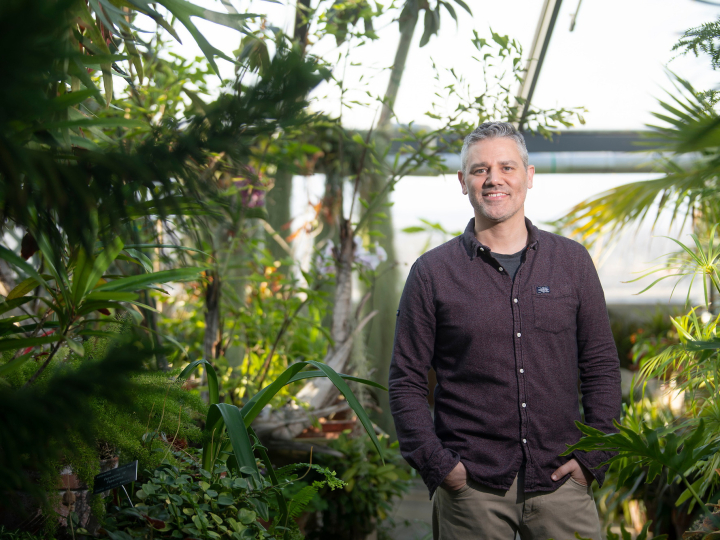Newly Discovered Fossils Help Bucknell Professor Shed Light on Area’s Prehistoric Past
October 12, 2016
A recently discovered and exceptionally diverse cache of fossils — including a fragment of one of the oldest ancestors of all land vertebrates — is giving Bucknell University professors and students a glimpse at life in Central Pennsylvania some 360 million years ago — and providing rich ground for student and faculty research.
The fossils were exposed several years ago during a highway widening project along Route 15, about 35 miles northwest of the Bucknell campus. Professor Dave Broussard of nearby Lycoming College was the first to take notice of the prehistoric fish fossils embedded in outcrops uncovered the construction and quickly called upon Bucknell Professor Jeff Trop, geology, to lend his expertise in characterizing the wetland environment the fossilized animals once inhabited.
Trop and Broussard unveiled the find at the Geological Society of America's annual meeting, held Sept. 25–28 in Denver.
The fossils date to the late Devonian Period, also called "The Age of Fish," which began some 419 million years ago and ended in a massive extinction, approximately 359 million years ago. They depict a diverse and rich ecosystem, "with plants on the stream banks, diverse fish inhabiting the stream channels, wetlands and lakes on the floodplains," Trop said.
Among the "hundreds and hundreds of fossils" Trop and Broussard chiseled from the rock face, one creature stands out as "super rare," Trop said. A femur bone about 2 inches long and a half-inch in diameter, it belonged to an early tetrapod — the very first vertebrates to evolve limbs from fins, which would allow them to crawl onto land for the first time.
"They led to amphibians, which led to reptiles, dinosaurs, birds and mammals," Trop said. "It all started with fish, really and then it's these early tetrapods — a group of fish developing fingers — that led to amphibians and, eventually, us."
All tetrapod fossils are rare, but they become more common in younger strata of late Devonian Period rock. The newly discovered fossil is among the oldest ever found — from one of the very first tetrapods, Trop said. The significance of the discovery is heightened by the fact that the tetrapod bone was found among hundreds of fish fossils, offering clues about the ecosystem the creature once inhabited.
"We have a really diverse assemblage of fish, in a stream channel and in the floodplain," Trop said. "We're starting to reconstruct the ecosystem right at the time when they start to develop as tetrapods."
In addition to the tetrapod, Trop and Broussard discovered fragments of more than a dozen genus of fish, as well as one of the oldest and best preserved groups of early freshwater clams ever found.
The fossilized species inhabited an ecosystem vastly different from the rolling hills and temperate forests that characterize Central Pennsylvania today, Trop explained. During the early Devonian Period, the path now tracked by Route 15 would have travelled — moving north to south — through a saltwater sea to the shoreline, then across wetlands, streams and rivers further to the south. Though overall the area was less verdant than it is today, the banks of those streams would have been stabilized by trees and other land plants allowing the streams to carve deeper channels. This greater depth, in turn, allowed fish to inhabit the streams for the first time.
"We can look at the transition from the shoreline to upland, fully terrestrial habitats," Trop said. "And we're seeing that there were diverse fish and tetrapod assemblages that had migrated into the stream systems and were living in a fully terrestrial habitat."
The new rock walls are far from the only sites for digging fossils in the area, which stands out in the Northeast as a region with remarkably diverse sedimentary strata that record the evolution of early life on Earth. For two decades, geologists have been returning to an outcropping of Devonian-period rock further to the west called Red Hill and more recently, during a class trip to a rock quarry in nearby Winfield, Pa., Trop and his students discovered one of the most significant assemblies of eurypterid, or "sea scorpion," fossils ever found in North America. Trop anticipates this new discovery will similarly offer years of research opportunities for professors and students.
That work was already begun by Rae Donofrio '16, who assisted Trop in analyzing fish fossils and other evidence about the local environment during the Devonian Period and the geology professor plans to involve another student researcher in field work at the site in summer 2017. Trop also brings his research work into the classroom through regular field trips to these and other field sites, including Winfield Quarry.
"They see sites that have active research going on," Trop said. "My paleontology class was in Winfield last week. They were able to read a published article and then go to the site where the features they read about had been discovered recently. They see science actually happening. These are sites where we're actively carrying out research, making discoveries and learning."
Trop likes to tell students about a class trip he led to Winfield Quarry, in which Kait Fleming '09 spotted the first in what turned out to be dozens of eurypterid fossils. The chance to make such discoveries themselves "really drives" the students, Trop said.
"Someone found something here that changed our understanding of the history of life," Trop said. "And they could do that, right here. They get so pumped about that."

